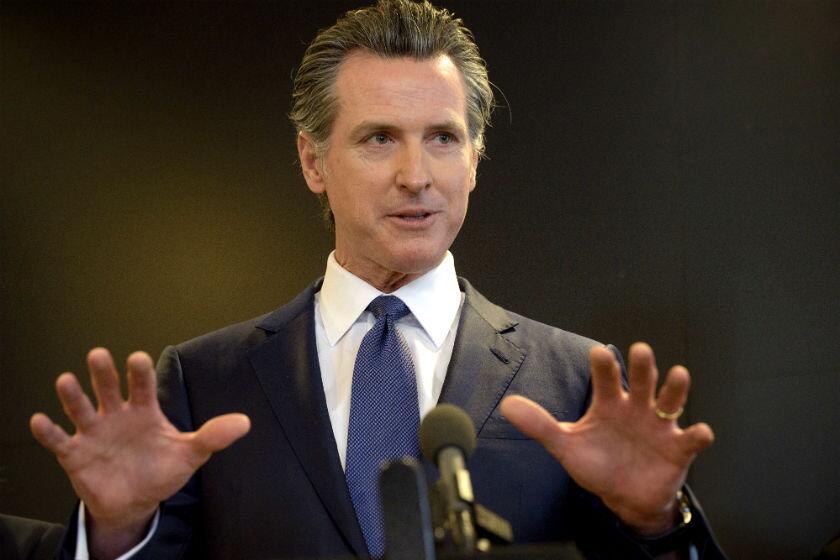When bills pile up, young people turn to strangers on Venmo
- Share via
Indira Marquez Robles felt helpless.
Just before her comparative politics class, the 19-year-old Oglethorpe University student learned that her stepfather had been arrested on suspicion of DUI and taken into Immigration and Customs Enforcement custody in Georgia. A tuition payment loomed. Legal fees would pile up. With the breadwinner behind bars, her whole family would feel the purse strings tighten.
For the record:
10:25 a.m. June 10, 2019This article incorrectly identifies Alice Marwick as a professor at Fordham University. Marwick left Fordham four years ago and works as a professor at the University of North Carolina at Chapel Hill.
So Marquez composed a tweet: “hey all i’m trying to keep my cool here but my dad has just been arrested...” Her mom needed money for gas to drive from Houston to visit him, Marquez wrote, and if anyone had anything to spare, they could find her on Cash App or Venmo, mobile payment apps that let users send cash to one another with just the click of a button.
With thousands of likes and retweets, donations broke $1,000 two days later — more than enough to cover gas for the drive.
Venmo, owned by PayPal, and Cash App, owned by Square, have surged in recent years, as cashless financial services moved into the mainstream. Some 40 million people use Venmo, and payments jumped by 73% to $21 billion in the first quarter of 2019 from a year prior. Cash App reported 15 million monthly active users as of December.
Most person-to-person payments are free, with the companies taking a cut from business transactions and those involving credit cards. Neither firm is profitable, but both boast sweeping popularity that PayPal and Square hope to monetize in the future.
The services frame themselves as tools that make it easy for their millennial and Gen Z user base to pay back a bar tab or split the cost of lunch. But some straddling tight budgets are also turning to payment apps as crowdfunding tools for bills, emergencies and the costs of daily life.
Tweets linking to Venmo and Cash App accounts are common in some pockets of Twitter, as users seek to crowdfund a few hundred dollars for rent or food, burdensome expenses such as medical bills, surgery, immigration fees, a family member’s funeral, and even a couple dollars for a cup of coffee or a trip to the nail salon.
Twitter user @queenofyelling summed it up with a tweet: “millennial culture is just passing around the same $20 to whoever needs it at the time forever.”
References to personal payment accounts are common on the social media profiles of people in online communities that coalesce around marginalized groups, including women, people of color, immigrants and LGBTQ-identifying individuals.
As gender pay gaps persist and racial wealth gaps widen, there is broader understanding of the toll that being female, transgender, black or brown has on one’s finances.
That perspective comes through in appeals for money. On International Women’s Day, for example, some Twitter users urged men to try to help level the playing field through Venmo.
Marquez’s stepfather stayed in the country illegally. Marquez herself is a recipient of the Deferred Action for Childhood Arrivals program, or DACA. When communities like hers come together on social media, they form a supportive network, she said.
“I use Twitter a lot anyways, and the community I’ve sort of met and connected with there is undocumented. They know the struggle,” Marquez said.
Marquez raised a total of $1,500, the majority from strangers online.
Pauline Elevazo, a student at Western Washington University, posted on Twitter after learning a $1.99 magazine subscription charge had bounced. Elevazo had just paid rent, with a tuition payment and a third notice for a medical bill lurking in her mailbox.
She still had a full day of classes to get through and no money to buy food.
In her spare time, Elevazo teaches Tagalog, a language spoken in the Philippines, as part of an offshoot program from her campus’ Filipino American Student Assn. She figured that because she provides a service that’s meaningful for her community for no pay, her followers might see the value in that. She had seen friends post on Twitter to crowdfund for tickets to raves, so why shouldn’t she ask for lunch money?
Within a day, she had $150 in donations, Elevazo said, enough for three weeks’ worth of groceries.
“There’s no shame in having to do it. Women of color, trans folks, queer folks — these institutions aren’t built to love us and support us. These institutions don’t care about our well-being,” Elevazo said. “Sometimes you have to turn to folks on the internet and their generosity, and that’s totally OK. It’s one less thing to worry about.”
Neither Venmo nor Square said they could provide data showing how often their applications were used for crowdfunding.
“We’re definitely not a GoFundMe and we certainly don’t facilitate charitable payments,” a Venmo spokesperson said. “A lot of use cases for Venmo are people splitting a dinner bill or utility bills, and it’s really happening between friends. If someone was going through a difficult situation and might need help with medical payments, for example, I’m sure that does happen, but we don’t have data to support it.”
Venmo, however, pointed to a few prominent, lighthearted examples of crowdfunding. Fans of “The Bachelor” sent contestant Becca Kufrin wine money on Venmo after she was dumped on national television, and more than 3,000 people sent a 23-year-old college student beer money after he held up a sign with his Venmo handle on the “College GameDay” telecast.
Such uses of Venmo and Cash App are an extension of the type of crowdfunding made popular by Kickstarter and Indiegogo, where people raise cash for particular projects, and Patreon, where creative workers seek compensation from their audiences, said Alice Marwick, a communication and media studies professor at Fordham University.
Crowdfunding platforms like GoFundMe and YouCaring have turned into popular avenues for Americans swimming in steep medical bills or funeral costs for loved ones.
In concept, crowdfunding from a Twitter community resembles a digital version of immigrant lending circles, or a modern version of a rent party — events that arose in the 1920s as African Americans migrating to Harlem leaned on their friends and communities to cover exorbitant, discriminatory rents.
Given today’s harsh economic realities, younger generations are demanding compensation rather than pretending they don’t exist, Marwick said.
Saddled with student debt and stagnant wages, young people are struggling to find the same level of financial security as older generations. Financial woes are often compounded for marginalized groups, with black college graduates, for example, owing $7,400 more on average than their white peers.
“[Crowdfunding] recognizes the financial constraints people are under and structural inequalities under capitalism — that some people just have less than others,” said Marwick, the Fordham professor. “The difference here is if you are someone who has extra money, you might want to give that money directly to someone you have something in common with or whose politics you understand rather than an organization where you don’t know what direct effect it will have.”
Mario Pizarro Rojas, a graduate student at Cal State Los Angeles, has used Venmo and Twitter frequently to crowdfund, including for tuition payments, a study abroad program, and a DACA renewal fee. When an expense more than a couple of hundred dollars comes up, Pizarro said, he might not necessarily have the means to cover it.
“It is hard to fund [a DACA renewal payment], but if I can’t pay for it then I can’t work legally in the country anymore,” Pizarro said. “It’s a weird cycle of trying to make ends meet little by little.”
Unlike Pizarro’s posts, some Twitter requests don’t specify what the money will go toward. Instead, they serve more as reminders of individuals’ difficult lives and the work they do behind the scenes that is often unacknowledged and unpaid, said Sarah Abdeshahian, who worked as a student organizer at UC Berkeley.
There’s been a “generational shift” in the way young millennials and Gen Z discuss labor, wrote Terry Nguyen, who produces a newsletter on Gen Z culture. “Through social media platforms, even the most niche hobbies and lifestyles can become monetized labor. Children grow up aspiring to be Youtubers. Teenagers rake in thousands of dollars selling slime,” Nguyen writes. “Nothing is done for free anymore. In fact, unpaid work is frowned upon and institutions that encourage free labor are shamed.”
Nicole Silverberg, a writer for “Full Frontal with Samantha Bee,” flips the practice on its head: She sets aside money to send through Venmo specifically for people she finds through Twitter. She started about a year ago after reading a tweet on International Transgender Day of Visibility that said, essentially, pay transgender people directly, because verbal support and donations to transgender advocacy organizations only go so far.
On the day Judge Brett M. Kavanaugh was confirmed by the Senate and sworn into the U.S. Supreme Court, Silverberg felt inundated by upsetting conversations about sexual assault on the news and social media.
So she asked her female, transgender and nonbinary Twitter followers if there was anything she could pay for to help them — a massage, a Crock-Pot or money for rent, she wrote.
Madison Geihs was a two-hour drive from her home in Orange County with an empty tank of gas, and broke, when — as luck would have it — she saw Silverberg’s tweet. Within minutes, Geihs received $40 from Silverberg through Venmo.
“She was trying to support other women on a day that was very hopeless for a lot of us,” Geihs said.
Silverberg doesn’t think people should have to justify expenses some might perceive as trivial — say ingredients for a fancy dinner or a massage — over fundamental costs such as rent.
“People who are concerned about money shouldn’t spend their whole day thinking about not having money and restricting themselves from having any joy in their lives,” Silverberg said. “It’s not like if you do that, suddenly your bills are paid.”
More to Read
Inside the business of entertainment
The Wide Shot brings you news, analysis and insights on everything from streaming wars to production — and what it all means for the future.
You may occasionally receive promotional content from the Los Angeles Times.










